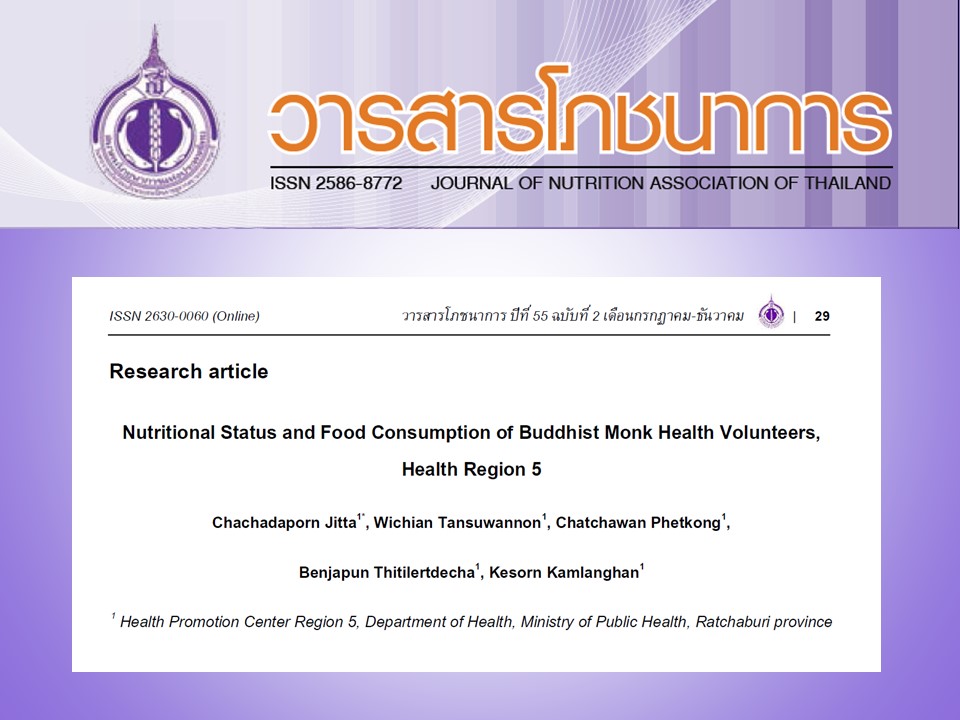Nutritional Status and Food Consumption of Buddhist Monk Health Volunteers, Health Region 5
Keywords:
Nutritional status, Nutrient intake, Buddhist monk health volunteerAbstract
This study aimed to assess nutritional status and food consumption of Buddhist monk health volunteers (BHVs). A cross-sectional descriptive study was conducted among 147 BHVs in December 2019. Body weight, height, and waist circumference (WC) were measured. Food consumption data were collected using a food frequency questionnaire and 2 days 24 hr dietary recall among 38 BHVs. Energy and nutrient intakes were calculated using the Thai NutriSurvey program. Data were analyzed using descriptive statistics and nonparametric statistics. The results showed that 38.8% of the participants were obese (BMI > 25 kg/m2) and 39.5% had WC > 90 cm. Polished rice was a staple food in 88.4 % of the participants. Top 3 animal protein food sources were lean meat, eggs, and fish (46.9%, 29.9%, and 27.2%). Vegetable and fruit intakes were 1-2 ladles/d and 1-2 portions/d, respectively which were lower than the recommendation by WHO (5 serving/d). Median daily energy intake was 1456 (P25, P75: 1245, 1655) kcal (70.2% of Thai DRIs 2020). Carbohydrate intake was 216.1 g/d. Protein intake was 51.5 g/d. Fat intake was 39.6 g/d. Distribution of energy intake from carbohydrate, protein, and fat was 59.4%, 14.1% and 24.5% of total energy intake, respectively. Sugar intake was 40.8 g/d (11.2% of total energy intake). Energy and nutrient intake of normal participants were not different from those of overweight and obesity participants (BMI ≥ 23 kg/m2). Participants in urban areas received vitamin B2 intake more than participants in rural areas. (P < 0.01). This study provides primarily evidence on dietary intakes of Buddhist monk health volunteers and such data can be used for developing nutrition media and strengthening the efficiency of promoting healthy meal for the BHVs.
References
สำนักข่าวเอชโฟกัส. คนไทยตายด้วยโรคNCDs ชั่วโมงละ 37 คน เร่งควบคุมป้องกันไม่ให้เกิดโรคแทรกซ้อน. [อินเทอร์เน็ต]. สำนักข่าวเอชโฟกัส.2561 ส.ค. 8 [เข้าถึง เมื่อ 3 ส.ค. 2563]. เข้าถึงได้จาก: https://www.hfocus.org/content/2018/08/16157
กลุ่มเทคโนโลยี ระบาดวิทยา และมาตรการชุมชน กองโรคไม่ติดต่อ. สำนักนโยบายและยุทธศาสตร์ สำนักงานปลัดกระทรวงสาธารณสุข. จำนวนและอัตราป่วยด้วยโรค NCDs 2559-2561. [อินเทอร์เน็ต]. 2562 [เข้าถึงเมื่อ 8 มี.ค.2563]. เข้าถึงได้จาก: http://www.thaincd.com/2016/news/hot-news-detail.php?id=13683&gid=18
ศรัณยา ทองทาบ. 5 โรครุมเร้าพระสงฆ์ วอนประชาชนจัดอาหารสุขภาพ. [อินเทอร์เน็ต]. บางกอกอินไซต์. 2562 พ.ค. 18 [เข้าถึง เมื่อ 13 เม.ย. 2563]. เข้าถึงได้จาก: https://www.thebangkokinsight.com/147401/
กรมการแพทย์ กระทรวงสาธารณสุข. เบาหวานในพระสงฆ์. สารกรมการแพทย์ 2561; 8:6-7.
จงจิตร อังคหะวานิช. สงฆ์ไทยไกลโรค สร้างพระสงฆ์ต้นแบบโภชนาการดี. [อินเทอร์เน็ต]. 2555 [เข้าถึง เมื่อ 10 เม.ย. 2563]. เข้าถึงข้อมูลได้จาก: https://www.thaihealth.or.th/Content/288-
สำนักงานงานเขตสุขภาพที่ 5 กระทรวงสาธารณสุข. ข้อมูลรายงานผลการคัดกรองสุขภาพพระสงฆ์ เขตสุขภาพที่ 5 เดือนกันยายน 2562.
กองพุทธศาสนสถาน สำนักงานศาสนสมบัติ สำนักงานพระพุทธศาสนาแห่งชาติ. ข้อมูลทะเบียนวัด ณ เดือนมกราคม พ.ศ. 2562. [อินเทอร์เน็ต]. 2562 [เข้าถึงเมื่อ 8 มี.ค.2562]. เข้าถึงได้จาก: http://www3.onab.go.th/2019/02/12/wattotalsummaryreport31012562/
Wayne W. Daniel. Biostatistics: A foundation for analysis in the health sciences. 9th edition. New York, John Wiley and Sons; 2009; 192-193.
กองโภชนาการ กรมอนามัย กระทรวงสาธารณสุข รายงานการสำรวจภาวะอาหารและโภชนาการของประเทศไทยครั้ง ที่ 5 พ.ศ.2546. กรุงเทพฯ: โรงพิมพ์องค์การรับส่งสินค้าและพัสดุภัณฑ์ (รสพ); 2549.
คณะกรรมการและคณะทำงานปรับปรุงข้อกำหนดสารอาหารที่ควรได้รับประจำวันสำหรับคนไทย ปริมาณสารอาหารอ้างอิงที่ควรได้รับประจำวัน สำหรับคนไทย พ.ศ. 2563 (Dietary Reference intake for Thais 2020). สำนักโภชนาการ กรมอนามัย กระทรวงสาธารณสุข นนทบุรี; 2020.
Lloyd-Jones DM, Hong Y, Labarthe D, Mozaffarian D, Appel LJ, Van Horn L, et al. Defining and setting national goals for cardiovascular health promotion and disease reduction: the American Heart Association's strategic Impact Goal through 2020 and beyond. Circulation. 2010; 121586–613.
Litchtman S, Pisarska K, Bermanet ER, al. Discrepancy between self-reported and actual calories intake and exercise in obese subjects. N Engl J Med. 1993; 327:1893-8.
Poppitt SD, SwannD, Black AE, Prentice AM. Assessment of selective under reporting of food intake by both obese and non-obese women in metabolic facility. Int J Obesity. 1998; 22:303-11.
Vasanti S Malik, Matthias B SchulZe, Frank B Hu. Intake of sugar-sweetened beverages and weight gain: a systematic review. Am J Clin Nutr. 2006; 84(2):274-288.
Vasanti S Malik, Barry M Popkin, George A Bray, Jean-Pierre Despress, Frank B Hu. Sugar-sweetened beverages, obesity, type 2 diabetes mellitus, and cardiovascular disease risk. Circulation. 2010; 121(11),1356-1364.
กลุ่มโรคไม่ติดต่อเรื้อรัง กรมควบคุมโรค กระทรวงสาธารณสุข. ยุทธศาสตร์ลดการบริโภคเกลือและโซเดียมในประเทศไทย พ.ศ.2559-568. กรุงเทพฯ: โรงพิมพ์ องค์การสงเคราะห์ทหารผ่านศึก ในพระบรมราชูปถัมภ์; 2559.

Downloads
Published
How to Cite
Issue
Section
License
Upon acceptance of an article, copyright is belonging to the Nutrition Association of Thailand.


